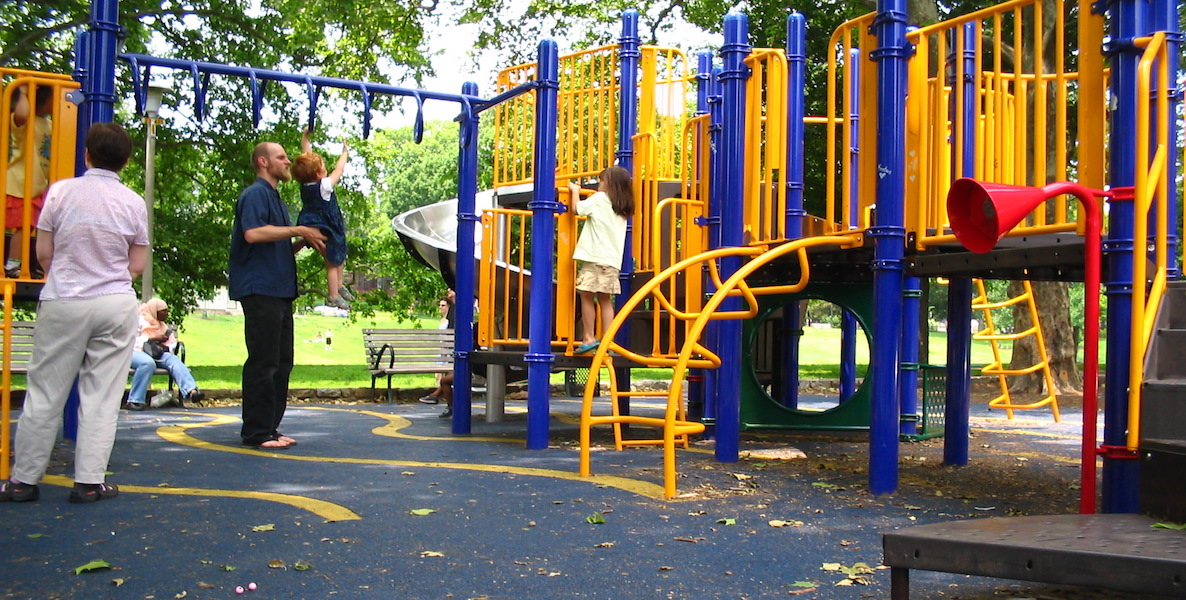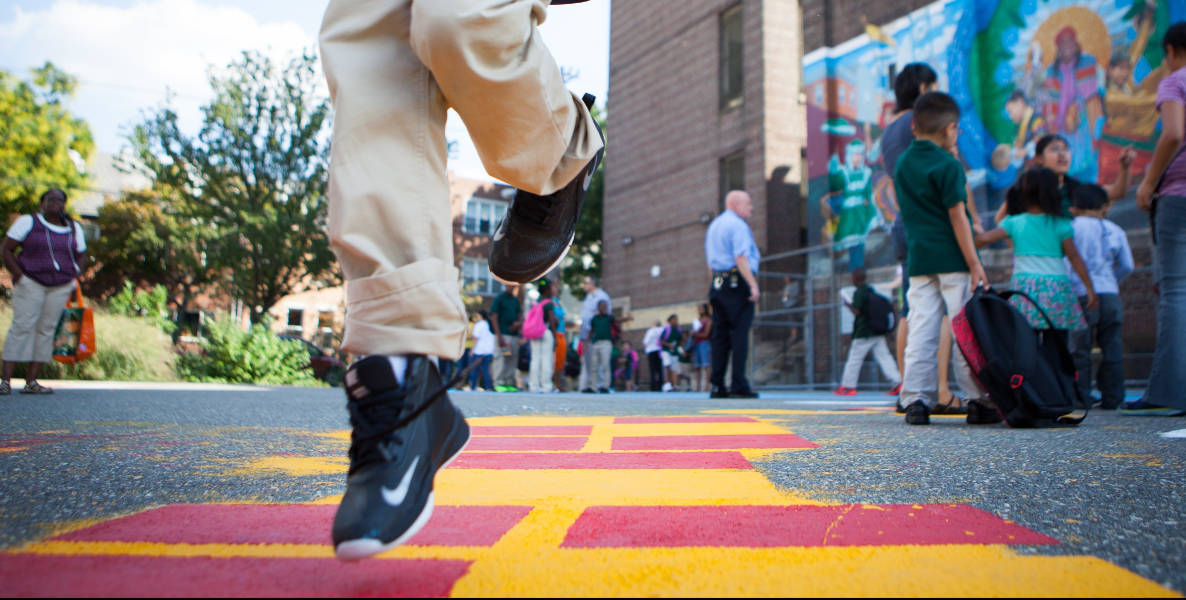Two years ago, when landscape architect Lois Brink brought her schoolyard redesign initiative to the city, it was with 25 years of experience in Denver, where she lives—and a dash of optimism for her hometown of Philadelphia.
Brink knew the state of Philly schoolyards was dire: We’ve all walked past and cringed at the deteriorating equipment, the graffiti, the mix of leaves and hoagie wrappers—an outward expression of what is often the physical state of school buildings, and of the education that goes on in some of them.
Brink knew there was another way. A landscape architecture professor at University of Colorado, Brink led the effort to turn all 96 of Denver’s public school playgrounds into “learning landscapes” that served two purposes: They provide a safe space for students to play during the school day, and are community parks in off-hours. Under the auspices of the Learning Landscapes Alliance, Brink developed 23 schoolyards before Denver voters got in on the act, approving two separate bond measures to allow her to fix up every elementary school yard in town by 2012.
The Mt. Airy native has since turned her attention to Philadelphia schools—at the urging of a former student who lives here—which for years had a reputation for being too bureaucratic to allow for real change. Undaunted, she started The Big Sandbox, which—when The Citizen first wrote about it last year—had worked with a handful of schools to redesign their yards. Now, that number is up to 22 schools.
To support their efforts, The Big Sandbox is holding its inaugural spring fundraiser on Wednesday night, at The African American Museum.
Brink’s work is, fundamentally, about school reform, in at least one sense: She believes that having a usable, welcoming outside impacts what goes on inside the school, both in terms of drawing in more local families and in terms of children’s ability to learn. “If it looks good on the outside, the chances of somebody walking in the door and going to a community school will be greatly, greatly enhanced, Brink explains. “And what the opportunity of being outside, in these spaces, can do to help the children navigate their cognitive skills in the building are huge.”
Brink’s work also ties into an educational movement touted by Mayor Kenney and the School District, which last month announced the plans for the nine schools chosen to become the District’s first “community schools”—making school facilities both educational for children and resources for the neighborhood. In Brink’s case, that resource is a public space for all.
A landscape architecture professor at University of Colorado, Brink led the effort to turn all 96 of Denver’s public school playgrounds into “learning landscapes” that served two purposes: They provide a safe space for students to play during the school day, and are community parks in off-hours.
This is not a message necessarily easy to get across to city officials, though. “I was disappointed to see when the soda tax went through, the rebuild dollars did not include the school yards,” Brink says. “They don’t see these added benefits yet, partly because we don’t have enough of them built.” (Brinks said she was heartened, though, that the District hired a landscaper to care for the school grounds.)
That could change soon, though. In its first couple years, The Big Sandbox took advantage of a program through the Philadelphia Water Department, which was already working with schools to replace blacktop with a greener, water permeable surface, as a way to help the city decrease its storm water pollution. This was a “win-win,” for everyone, and led to The Big Sandbox’s first two success stories, at South Philly’s George W. Nebinger Elementary and Kensington’s Horatio B. Hackett.
Brink created an exchange program with landscape architecture departments at three universities, Iowa State University, University of New Hampshire and University of Colorado. This program allows graduate students to get hands on experience in the field, designing and developing plans for the school yard and its estimates costs. “One of the biggest things we’ve been able to do is to talk about this idea of a Philadelphia schoolyard exchange program,” Brink says. “That can really help scale working with the communities, which we see as a critical piece.”
Several of the graduate students focused on six Mt. Airy schools. “Having grown up in Mt. Airy, I got to give them some of my thoughts about schools in that area, which was pretty cool,” Brink says with a chuckle.
Brink’s work is, fundamentally, about school reform, in at least one sense: She believes that having a usable, welcoming outside impacts what goes on inside the school, both in terms of drawing in more local families and in terms of children’s ability to learn.
But the group has especially focused on lower-income neighborhoods in North Philadelphia, where school communities have fewer resources, both in terms of money and support. Brink says her biggest push right now is planning playground redesigns for 10 schools in North Philly, which she admits will take a longer time to bring to fruition. “They don’t necessarily have the capacity to go out and raise additional funds on the side to help improve their school yard projects,” she notes.
In the last year, The Big Sandbox has increased by 20 the number of schools they’ve helped in some way—five in South Philadelphia, six in Mt. Airy, 10 in North Philly and one in Kensington. Brink and her team created 10 design plans last fall alone. Construction has not started yet on these plans; this requires, more than anything, fundraising. “They are moving school yard designs forward, but their process takes time,” she says.
Brink attributes The Big Sandbox’s rapid growth to the work of local communities, which she says have embraced their approach, a collaboration between the needs of the school and the needs of the neighborhood. She hopes that excitement puts some political pressure on officials. “If the community is excited about their school yard, then it makes it more difficult for them to close that school,” she says.
To that end, Brink says The Big Sandbox is always looking for more volunteers and for more donations, to help with their community engagement efforts. Wednesday’s fundraiser could be a good place to start.
Header photo: Kim Woodbridge, via Flickr.



